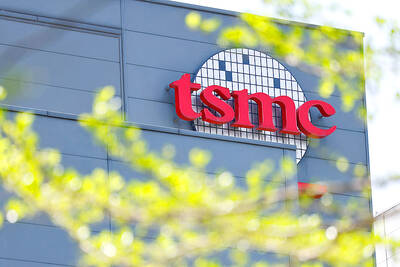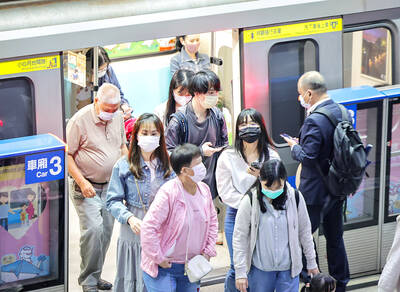The number of tactical ballistic missiles deployed by China against Taiwan reached more than 1,400 at the end of last year, said the National Security Council (NSC), which said in May 2006 that the figure would rise to more than 800 by the end of that year.
An NSC report released on March 26 said that China had more than 190 cruise missiles targeting Taiwan at the end of last year, rising from more than 100 a year before.
The council said the deployment “allows the People's Liberation Army [PLA] to launch a nine-wave, 12-hour saturation missile attack on Taiwan and conduct precision strikes on more than 100 key targets in Taiwan.”
The report was an update on the 2006 report —– the first ever released by the council to state in detail the government's views on internal and external threats since the nation's highest intelligence agency, presided over by the president, became a legal institution in 1993.
Included in this year's report were the PLA navy's (PLAN) 400km-range YJ-62A anti-ship cruise missiles and submarine-launched anti-ship submarines.
“PLAN has more than 1,000 ships of various types and more than 250,000 personnel. The number of its new large-sized naval vessels and submarine-launched anti-ship submarines had increased to 30 each by the end of last year, which, together with the deployment of YJ-62A anti-ship cruise missiles, equipped the PLAN with the capability to blockade the Taiwan Strait, the northeastern and southwestern waters of Taiwan proper,” the report said.
The report said the PLA Air Force (PLAAF) was preparing to deploy 200km-range S-300 PMU2 anti-aircraft missiles, which, along with its new-generation Air Early Warnings, electric warfares, and more than 10 types of stand-off weapons, “had reduced Taiwan's strategic depth and imposed threats to military and civil aviation in the airspace around Taoyuan and Hsinchu.”
It said the PLAAF had increased its fleet of new-generation fighter aircraft of various types at a rate of 70 a year, with the number growing to 550 by the end of last year.
The Chinese military's successful test-firing in January of its Dong Feng 25 ballistic missile against a weather-satellite marked significant progress in China's space technology in terms of satellite tactical communications, satellite electronic reconnaissance, satellite oceanic navigation and satellite meteorological observation, the report said.
“The PLA possesses all-day technology for aerial surveillance, satellite imagery and topography, which can enhance its ability to precisely attack targets in Taiwan,” the report said.
NSC said China had revealed its ambition to expand its sea power to the high seas.
“In 2007, China's ocean exploration ships conducted 14 sorties in the waters around Taiwan in the name of oceanic survey, intelligence and technology,” it said.
The full text of the report in Mandarin is available on the Presidential Office's Web site. An English version will be publicized at a later date.

EUROPEAN TARGETS: The planned Munich center would support TSMC’s European customers to design high-performance, energy-efficient chips, an executive said Taiwan Semiconductor Manufacturing Co (TSMC, 台積電), the world’s largest contract chipmaker, yesterday said that it plans to launch a new research-and-development (R&D) center in Munich, Germany, next quarter to assist customers with chip design. TSMC Europe president Paul de Bot made the announcement during a technology symposium in Amsterdam on Tuesday, the chipmaker said. The new Munich center would be the firm’s first chip designing center in Europe, it said. The chipmaker has set up a major R&D center at its base of operations in Hsinchu and plans to create a new one in the US to provide services for major US customers,

The Ministry of Transportation and Communications yesterday said that it would redesign the written portion of the driver’s license exam to make it more rigorous. “We hope that the exam can assess drivers’ understanding of traffic rules, particularly those who take the driver’s license test for the first time. In the past, drivers only needed to cram a book of test questions to pass the written exam,” Minister of Transportation and Communications Chen Shih-kai (陳世凱) told a news conference at the Taoyuan Motor Vehicle Office. “In the future, they would not be able to pass the test unless they study traffic regulations

‘A SURVIVAL QUESTION’: US officials have been urging the opposition KMT and TPP not to block defense spending, especially the special defense budget, an official said The US plans to ramp up weapons sales to Taiwan to a level exceeding US President Donald Trump’s first term as part of an effort to deter China as it intensifies military pressure on the nation, two US officials said on condition of anonymity. If US arms sales do accelerate, it could ease worries about the extent of Trump’s commitment to Taiwan. It would also add new friction to the tense US-China relationship. The officials said they expect US approvals for weapons sales to Taiwan over the next four years to surpass those in Trump’s first term, with one of them saying

‘COMING MENACINGLY’: The CDC advised wearing a mask when visiting hospitals or long-term care centers, on public transportation and in crowded indoor venues Hospital visits for COVID-19 last week increased by 113 percent to 41,402, the Centers for Disease Control (CDC) said yesterday, as it encouraged people to wear a mask in three public settings to prevent infection. CDC Epidemic Intelligence Center Deputy Director Lee Chia-lin (李佳琳) said weekly hospital visits for COVID-19 have been increasing for seven consecutive weeks, and 102 severe COVID-19 cases and 19 deaths were confirmed last week, both the highest weekly numbers this year. CDC physician Lee Tsung-han (李宗翰) said the youngest person hospitalized due to the disease this year was reported last week, a one-month-old baby, who does not